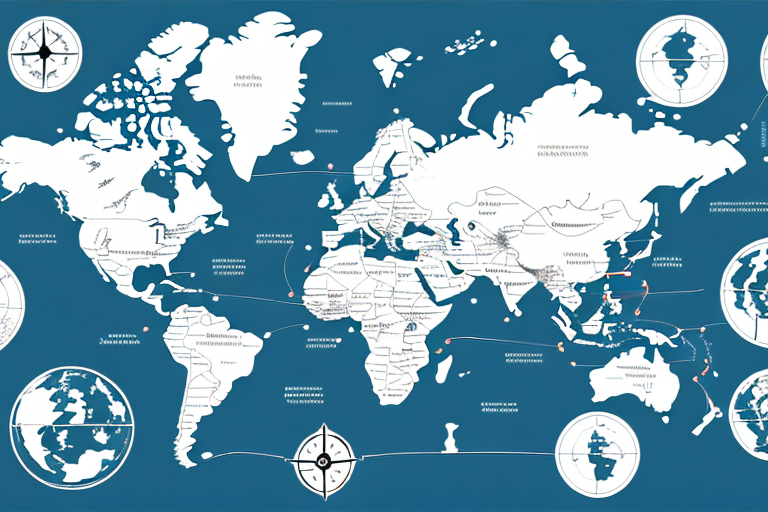Discover the Best UPS Shipping Rates for Your Business
As a business owner, finding the best shipping rates for your products is crucial. Not only can it affect your bottom line, but it can also impact customer satisfaction. When it comes to shipping, UPS is a popular carrier choice for many businesses. In this article, we will explore how UPS shipping rates are determined, the impact of shipping zones, tips for negotiating better rates, how to calculate shipping costs, and more to help you discover the best UPS shipping rates for your business.
Why Finding the Best UPS Shipping Rates is Important for Your Business
Shipping costs can add up quickly and have a significant impact on your business’s profitability. According to industry reports, businesses can spend up to 20% of their revenue on shipping. That’s why it’s critical to find the best shipping rates possible to keep costs low. Additionally, offering competitive shipping rates can attract and retain customers, leading to increased sales and customer loyalty.
Another reason why finding the best UPS shipping rates is important for your business is that it helps you stay competitive in the market. With the rise of e-commerce, customers have become more accustomed to free or low-cost shipping. If your business can’t offer competitive rates, customers may choose to shop elsewhere.
Furthermore, optimizing your shipping rates can streamline your shipping process. By partnering with a reliable carrier like UPS, you ensure that your packages are delivered on time and in good condition, which can lead to increased customer satisfaction and repeat business.
How UPS Shipping Rates are Determined
Several factors determine UPS shipping rates, including:
- Package Weight: Heavier packages incur higher shipping costs.
- Package Size: Larger packages may require additional handling fees.
- Destination: Shipping distances affect the rate, categorized into shipping zones.
- Shipping Service: Faster services like overnight shipping cost more than ground services.
- Declared Value: Higher declared values increase shipping costs to cover potential loss or damage.
Additionally, UPS considers the distance between the shipping origin and destination to assign the shipment to a specific shipping zone. The type of shipment (ground vs. air) and the desired delivery speed also play crucial roles in determining the final shipping rate.
For more detailed information on how UPS calculates shipping rates, you can refer to the UPS Shipping Calculator.
Understanding UPS Shipping Zones and Their Impact on Shipping Rates
UPS divides the United States into nine shipping zones to determine shipping rates based on distance and location. Zone 1 is designated for local packages, while Zone 9 covers packages that travel across the country. The farther the package needs to travel, the higher the shipping cost will be.
Businesses that frequently ship to higher-numbered zones should consider negotiating better rates with UPS or exploring alternative shipping options to minimize costs. Understanding these zones can also help in planning logistics and managing delivery expectations.
Moreover, UPS offers guaranteed delivery times for packages shipped within the same zone. For instance, packages shipped within Zone 1 can receive faster delivery times compared to those traveling to Zone 9, which require more time due to the greater distance.
Tips for Negotiating Better Shipping Rates with UPS
As a business owner, you have the leverage to negotiate better shipping rates with UPS. Here are some effective strategies:
- High-Volume Shipping Discounts: Inquire about discounts for businesses that ship in large quantities.
- Committed Shipping Volumes: Enter agreements to commit to a minimum shipping volume in exchange for reduced rates.
- Optimize Packaging: Reducing the size and weight of packages can qualify you for lower shipping rates.
- Utilize UPS Packaging Options: Using UPS's flat-rate boxes can help standardize shipping costs and save money.
Additionally, leveraging competition by comparing rates with other carriers can provide a basis for negotiation, ensuring you receive the best possible rates from UPS.
For more negotiation tips, refer to ShipScience's guide on shipping software.
How to Calculate Shipping Costs with UPS
Calculating shipping costs with UPS is straightforward using their online tools. The UPS Shipping Cost Estimator considers package weight, dimensions, destination, and service type to provide an estimate for your shipment’s cost.
To ensure accuracy, it's essential to weigh and measure your packages precisely. This information will help you select the most cost-effective shipping option that meets your delivery timeframe.
UPS offers various shipping options, including ground, air, and international shipping, each with different delivery times and costs. Additionally, businesses that ship regularly may qualify for business discounts, making it worthwhile to inquire about these savings.
Comparison of UPS Shipping Rates with Other Carriers
Comparing UPS shipping rates with other carriers like FedEx and USPS is essential to find the best option for your business needs. Key factors to consider include:
- Shipping Speeds: Compare the delivery times offered by each carrier.
- Service Types: Evaluate the range of services, such as overnight or international shipping.
- Shipping Zones: Assess how each carrier defines and prices their shipping zones.
- Pricing: Look at the overall cost, including any additional fees or discounts.
For example, while UPS might offer competitive rates for international shipments, USPS could be more cost-effective for smaller packages within the domestic market. FedEx, on the other hand, may provide faster delivery options for urgent shipments.
By analyzing these factors, you can make an informed decision on which carrier aligns best with your shipping requirements and budget.
Different Types of UPS Shipping Services and Their Costs
UPS offers a variety of shipping services tailored to different business needs:
- Ground Shipping: The most common and affordable option for non-urgent deliveries.
- Air Shipping: Provides faster delivery times at a higher cost.
- Freight Shipping: Ideal for larger items that exceed standard package sizes.
- International Shipping: Facilitates global business operations with a range of international services.
- Express Saver: Guarantees delivery by the end of the next business day to most locations worldwide.
Additionally, UPS offers value-added services such as UPS My Choice, which allows customers to customize delivery preferences and receive real-time delivery alerts. These services enhance the shipping experience by providing greater control and visibility over shipments.
How to Choose the Right UPS Shipping Service for Your Business Needs
Choosing the right UPS shipping service involves assessing your business’s specific needs, including the types of products you ship, desired delivery timeframes, and your budget constraints. Consider the following factors:
- Delivery Speed: Determine how quickly your products need to reach customers.
- Package Size and Weight: Select services that accommodate your package dimensions and weight.
- Tracking and Visibility: Opt for services that offer real-time tracking and delivery notifications.
- Customer Support: Ensure the shipping service provides reliable customer support to address any issues.
- Additional Features: Consider services like insurance or package pickup that may benefit your operations.
By carefully evaluating these factors, you can select a UPS shipping service that best aligns with your business objectives and enhances your overall shipping strategy.
Pros and Cons of Using UPS for Shipping
Like any shipping carrier, UPS has its advantages and disadvantages:
- Pros:
- Wide range of shipping services suitable for various business needs.
- Competitive pricing, especially for businesses with high shipping volumes.
- Reliable delivery with a strong reputation for on-time performance.
- Extensive network of over 40,000 drop-off locations worldwide.
- Advanced tools and resources, such as online tracking and shipping software.
- Cons:
- Higher costs for certain shipping services compared to other carriers.
- Customer support can sometimes be challenging to reach.
- Environmental impact due to a large fleet of delivery vehicles contributing to greenhouse gas emissions.
- Occasional reports of lost or damaged packages requiring time-consuming resolutions.
Overall, UPS remains a strong contender in the shipping industry, offering robust services that cater to a wide array of business requirements.
How to Save Money on Shipping Costs with UPS
Implement the following strategies to reduce your shipping expenses with UPS:
- Negotiate Better Rates: Engage with your UPS account representative to secure discounts based on your shipping volume.
- Utilize Flat-Rate Shipping: For smaller items, use UPS's flat-rate boxes to standardize and potentially lower shipping costs.
- Explore Bulk Shipping Discounts: Commit to bulk shipments to take advantage of volume-based savings.
- Print Labels at Home: Use UPS’s online services to print your shipping labels, avoiding additional carrier fees.
Additionally, optimizing your packaging to reduce size and weight can lead to significant savings. Regularly reviewing your shipping patterns and adjusting your strategy accordingly can also help in maintaining cost-effective shipping operations.
Common Mistakes to Avoid When Using UPS for Shipping
Avoid these common errors to ensure a smooth shipping experience with UPS:
- Incorrect Package Weight and Dimensions: Always accurately measure and weigh your packages to prevent incorrect shipping cost estimates and potential delays.
- Not Exploring Available Discounts: Failing to take advantage of UPS’s various discount programs can result in higher shipping costs.
- Poor Packaging: Inadequately packaged items are more susceptible to damage, leading to increased costs and customer dissatisfaction.
- Neglecting Tracking and Insurance: Not using tracking services or declaring the appropriate value can lead to issues if packages are lost or damaged.
By being mindful of these mistakes, you can enhance your shipping efficiency and reduce unnecessary expenses.
Tracking Your Shipments with UPS
UPS offers robust tracking capabilities that allow businesses to monitor their shipments in real-time. Their tracking system provides updates on the package’s location, transit status, and estimated delivery time. This transparency enables businesses to keep customers informed and manage expectations effectively.
Additionally, UPS My Choice for Business offers enhanced tracking features, including delivery alerts and the ability to reroute packages if necessary. Utilizing these tools can significantly improve your shipping management and customer satisfaction.
Customer Service Support by UPS for Businesses
UPS provides comprehensive customer service support tailored for business needs. Businesses can access support via multiple channels, including:
- Phone: Dedicated customer service lines for immediate assistance.
- Email: Convenient email support for non-urgent inquiries.
- Online Chat: Real-time assistance through the UPS website.
For businesses with high-volume shipping requirements, UPS offers account representatives who provide personalized support and guidance. This dedicated service ensures that businesses receive timely and effective solutions to their shipping challenges.
Real-life Examples of Businesses Saving Money on Shipping Costs with UPS
Many businesses have successfully reduced their shipping costs by optimizing their UPS shipping strategies. Here are a few examples:
- Retail Company: By switching to UPS from another carrier and negotiating better rates, a retail business saved 15% on their shipping expenses.
- Small E-commerce Store: Implemented flat-rate shipping for smaller items and ground shipping for larger products, resulting in significant cost savings and streamlined operations.
- Manufacturing Firm: Utilized UPS’s bulk shipping discounts and optimized packaging processes to reduce overall shipping costs by 10%.
These examples illustrate that with proper planning and negotiation, businesses can achieve substantial savings on shipping costs while maintaining reliable service for their customers.
In conclusion, finding the best UPS shipping rates for your business requires research and strategic planning. By leveraging available discounts, optimizing your shipping processes, and selecting the right UPS services, you can save money and offer competitive shipping rates that enhance customer satisfaction and drive business growth.






















